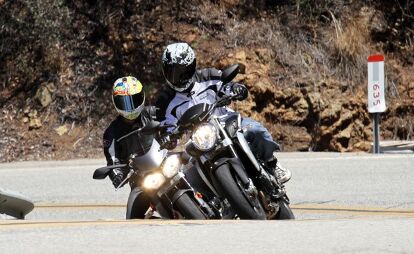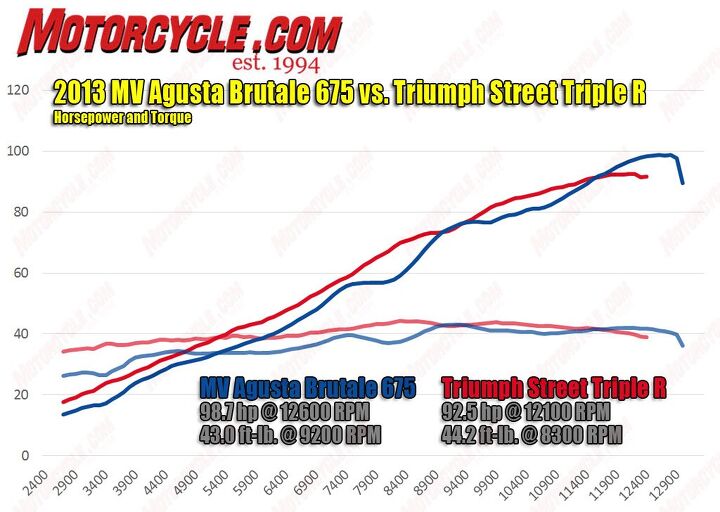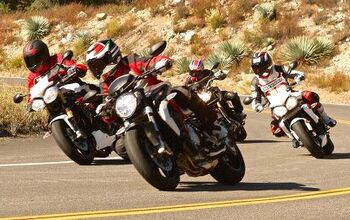2013 MV Agusta Brutale 675 Vs. Triumph Street Triple R – Video
European three-cylinder streetfighters go into battle
It’s a time of feasting for fans of streetfighters and hooligans. The category is so chock full of badass nakeds we had to create a category unto streetfighters for our 2013 Motorcycle Of the Year awards. Between these two manufacturers alone exist 10 streetfighters of differing levels of performance. For this shootout we chose only two … an exceptionally good two!
2012 MV Agusta Brutale 675 Review
MV Agusta’s Brutale 675 was introduced in 2012, while Triumph’s Street Triple R received a makeover prior to entering the 2013 model year. The commonality among them is their 675cc inline-Triple engines, superbike handlebars and lack of sportbike bodywork. From here the two bikes diverge in performance mannerisms, technologies, price and visual appeal. Which manufacturer concocted a better middleweight two-wheel ruffian is what we’ll now determine.
Both bikes share an engine architecture of three liquid-cooled, inline cylinders, but the Brutale’s bigger bore and shorter stroke (79.0 x 45.9 mm) make for a revvier engine compared to the Triumph’s smaller bore and longer stroke (74.0 x 52.3) – the Brutale exhibiting an unmistakable stepped powerband compared to the STR’s linear power delivery.
“Relative to the Triumph, the Brutale’s motor delivers power like a two-stroke, with an immediate, jabbing response unlike any four-stroke production bike I’ve ridden,” says Chief Editor, Kevin Duke.
Coupled with a light throttle return spring, a disconnected-feeling Ride-by-Wire throttle and irregular low-rpm fueling, the Brutale lives up to its given namesake: brutal.
“As usual for recent MVs, the R-b-W throttle response lacks any grace,” laments Duke. “Of all the R-b-W throttles I’ve sampled, MV’s feel the least connected – it’s the bike’s worst attribute.”
Another way to look at it, though, is through the eyes of our guest tester, Sean Matic. “I really like the Brutale’s 3-cylinder engine,” he says. “I like the sound, the induction howl, the way it takes off when it hits its powerband, the split of good torque from the Triple configuration but as much on top as an inline-Four due to its oversquare design.”
He does concede, however, that MV “needs to get their R-b-W tech better sorted.”
On the flip side is the Street Triple R and its nearly faultless fueling and power delivery. Compared to the MV, the STR feels incredibly refined, as though it graduated finishing school whereas the MV was a first year dropout. In a strange twist of hooligan etiquette, the STR may be too genteel, as if Triumph manufactured the hooliganism out of its hooligan bike. Much of this is attributed to the bike’s new, taller first gear that stretches to 77 mph before hitting the rev limiter.
2013 Triumph Street Triple R Review
“It will no longer wheelie off the throttle in first gear, necessitating a bounce and tug or a clutch drop,” wheelie-hound Duke complains.
“I think the final drive gearing and tall first gear really neuter the thrust compared to the B3,” says Matic. “In tight canyons, ridden next to the B3 the STR feels smooth, even, controllable, smoothly fueled, but a bit slower, especially when exiting tight corners.”
The inability of the STR to loft the front end under its own power when in first gear (without help from the clutch) while the Brutale can barely keep its front wheel on the tarmac is shameful. There exists, however, a tradeoff and resultant attribute we preferred in the Triumph: stability.
Fuel Economy and Range
| Tank Capacity | Average MPG | Fuel Range | |
|---|---|---|---|
| MV Agusta Brutale 675 | 4.4 gal. | 34.3 mpg | 151 miles |
| Triumph Street Triple R | 4.6 gal. | 39.4 mpg | 181 miles |
With a one-inch shorter wheelbase the B3 is quick to turn in to and out of a corner, whereas the Triumph is slightly more lethargic. Once in the corner, though, the MV feels flighty and nervous while the Triumph maintains its composure. A steering damper would help calm the MV’s front end, but recognition must be given to the Triumph’s superior, adjustable suspension components and their ability to better handle gnarled canyon blacktop.
“Although similar in specs and intent, the Brutale makes the ST-R feel sluggish, both in its power production and its steering responses,” says Duke of the Brutale. While Matic’s impression of the Triumph is that it feels slow turning compared to the B3 but offers better stability and more even-temperedness during quick transitions. “It just does what you ask of it without any fuss,” says Matic.
Both machines wear name-brand braking components: Nissin on the STR and Brembo on the Brutale, the key difference being the radial master cylinder attached to the Triumph’s handlebar.
“The STR’s front brakes are much stronger with much more feel than the B3’s Brembos,” says Matic. Repeatedly riding through the same corner on both bikes revealed just how much more force the Brembos required to get the same braking results. And that’s with 310mm discs on the Triumph compared to the MV’s 320mm front discs.
MV Agusta Brutale 675
+ Highs
- Sharp handling
- Light weight
- Gorgeous, of course
– Sighs
- Non-adjustable suspension
- Underperforming brakes
- Unacceptable low-rpm fueling
A slight touch of the Brutale’s rear brake, however, easily locks the rear tire, making it damn near useless outside of intended rear-wheel slides. The STR, on the other hand, comes equipped with ABS, eliminating slides – desired or not.
Which brings us to the technological differences a prospective customer has to choose between on these two fighters. Where Triumph brings the aforementioned ABS and adjustable suspension (lacking only rear compression damping) to the table, the MV foregoes these technologies in favor of ride modes and TC.
The problem for the Brutale is that the abominable low-rpm fueling renders Sport mode all but unusable. Choosing Normal mode calms throttle response but with the penalty of laggardly off-idle reaction. Thankfully there’s a Custom setting in which several parameters can be set, and the maps selected when we got the bike offered the best balance of responses.
MV’s TC is appreciated due to the Brutale’s hard-hitting powerband, while it’d be a wasted technology on the Triumph and its easily controllable power delivery. Therefore, it seems obvious to us that Triumph’s ABS and adjustable suspension are the sensible choice.
Triumph Street Triple R
+ Highs
- Adjustable suspension
- Less money than Brutale
- Linear handling & power delivery
– Sighs
- Tall first gear
- Under-engine exhaust is fugly
- Uh… give us a minute
And though the Triumph is an attractive bike, it can’t help but play wallflower to the B3’s supermodel profile.
“While the Brutale has one of the coolest exhaust systems of the modern era, the Street Trip’s new exhaust looks as ordinary as a hammer,” smirks Duke.
Individual Tester Scorecard
| Tom | Sean | Total | |
|---|---|---|---|
| MV Agusta Brutale 675 | 85.0% | 87.5% | 86.3% |
| Triumph Street Triple R | 94.0% | 92.1% | 93.3% |
So it is, by virtue of its lesser price, standard ABS, adjustable suspension, vastly superior fuel mapping, better brakes and all-around user-friendliness, we deem the Street Triple R the better choice between these two bikes.
However, as Mr. Matic enthused in our discussions, the Brutale and its visual appeal and dramatic engine characteristics plucks his heartstrings more than the Triumph, providing an intangible argument for coughing up the extra $1k needed to purchase to the Brutale.
And while the MV’s flawed throttle response spoiled the experience for Duke, he nevertheless was seduced by the Italian diva. “Its symphonic engine note sounds way more exotic than the bike’s price,” he raves. “I hear what sounds like a baby V-12 as intake funnels slurp air and the short-exit exhaust piping blats music just behind my ears. I hated to give this one back.”
675cc Streetfighter Specs
| MV Agusta Brutale 675 | Triumph Street Triple R | |
|---|---|---|
| MSRP | $10,998 | $9,999 |
| Horsepower | 98.7 @ 12,600 rpm | 92.5 @ 12,100 rpm |
| Torque | 43.0 ft-lb. @ 9300 rpm | 44.2 ft-lb. @ 8300 rpm |
| Engine Capacity | 675 cc | 675 cc |
| Engine Type | Inline 3-cylinder | Inline 3-cylinder |
| Bore x Stroke | 79.0 x 45.9 mm | 74.0 x 52.3 mm |
| Transmission | Cassette-style 6-speed | 6-speed |
| Final Drive | Chain | Chain |
| Frame | Steel tubular trellis | Aluminum twin-spar |
| Front Suspension | 43mm Marzocchi inverted | 41mm KYB inverted fully adjustable |
| Rear Suspension | Sachs monoshock adjustable preload | KYB monoshock with piggy back reservoir adjustable for rebound and compression damping, |
| Front Brakes | Double floating disc with 320 mm diameter, Brembo calipers | Twin 310mm floating discs. Nissin 4-piston radial calipers.(Switchable ABS as standard) |
| Rear Brakes | Single steel disc with 220 mm diameter, Brembo caliiper | Single 220mm disc, Brembo single piston caliper. (Switchable ABS as standard) |
| Front Tire | 120/70-17 | 120/70-17 |
| Rear Tire | 180/55-17 | 180/55-17 |
| Seat Height | 31.9” | 31.5” |
| Wheelbase | 54.3” | 55.5” |
| Curb Weight | 395 lbs | 403 lbs |
| Fuel Capacity | 4.4 gal | 4.6 gal |
| Electronics | TC, ride mode | ABS |
| Warranty | 24 months | 24 months |
A former Motorcycle.com staffer who has gone on to greener pastures, Tom Roderick still can't get the motorcycle bug out of his system. And honestly, we still miss having him around. Tom is now a regular freelance writer and tester for Motorcycle.com when his schedule allows, and his experience, riding ability, writing talent, and quick wit are still a joy to have – even if we don't get to experience it as much as we used to.
More by Tom Roderick


























































Comments
Join the conversation
I'm writing from Australia and am not sure about the similarity of the specs for the MV between our 2 countries but just wanna say that a mate of mine owns an MV which spends more time at the dealer getting its electronics sorted than it does on the road. It's highly temperamental, refusing to start on several occasions, including while out on rides, far removed from the city. Perhaps you should run long term tests to uncover problems such as these that do not show up in the showroom or on short rides where prospective buyers may be dazzled, only to be frustrated and angered when the darn thing won't start!!
It was great to stumble upon this post. Has anyone ever wondered how to fill out forms online? I have, and found a simple service. BTW, if anyone needs to fill out a a form, I found a blank fillable form here http://goo.gl/umruko